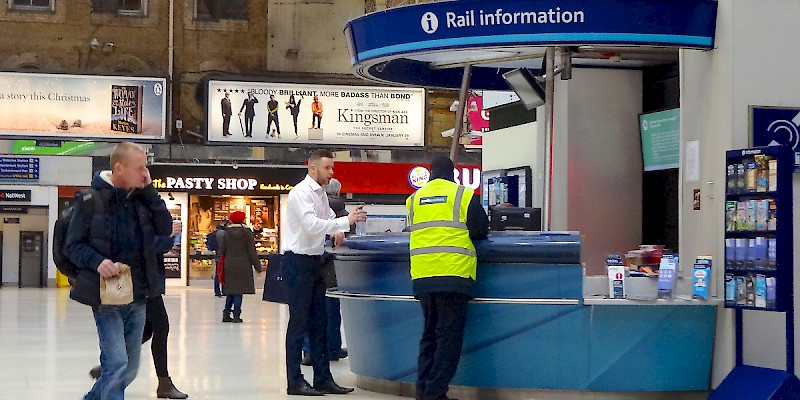Train stations

Like the trains themselves, European train stations tend to be clean and user-friendly—with tourist info, hotel booking service, left luggage lockers or offices, and decent snack bars (in case you forget to pick up train picnic supplies in town)
European rail stations are much more than just place to hop a train.
They have ATMs, hotel booking services, photo booths, baggage storage lockers (or a left luggage office), cafes, tourist info offices, newsstands (which, alongside the newspapers, is also the best place to find city maps, local bus tickets, and postal stamps), restrooms, and in bigger cities, often plenty of shops and 24-hour chemists (pharmacies).
If you know how to use the train station for all it's worth, you can spend 20 minutes there when you first arrive in a city and come out of it well-oriented and fully armed for your visit.
Arriving in town
- Stop by the station's ATM or bank for a bit of local cash (not too much; a downtown branch might have better exchange rates).
- Hit the tourist board kiosk or desk and milk it for all the free info, maps, and brochures you can get.
- Visit a newsstand to see whether the city maps for sale are better than the free one from the tourist office (usually the answer is yes, and the investment is worth it). Pick up a phone card (if you don't have a mobile you can use), grab a few city bus tickets to get you started, and buy the local information/events magazine (e.g.: Time Out London).
- Now that you have some pocket change, you may want to dump your main bag in a locker or left luggage office for $2 to $10 a day and keep just your daypack. If you're just dropping by town for a half-day visit, the bags will stay there. If you're spending the night, go hotel hunting without your pack, and you'll have more stamina and bargaining leverage to get the best deal.
- Head to the phones and call around for a hotel, or use the station's hotel booking service.
- Before you exit the station upon arrival, check out your train options for leaving town a few days down the line (as well as for any day trips you plan to make). That way, you can swing by a day or two before you leave to buy your tickets and reserve seats or couchettes rather than wait until the last minute when the lengthy ticket lines may thwart your precision-timed plans.
Leaving town
The rail information desk —not to be confused with the city tourist board's desk, because the two won't answer each other's questions—usually has a long line, and the staff was born harried. Use the do-it-yourself information sources as much as possible.
Modern stations in big cities often have computerized rail information kiosks and automatic ticketing machines , but both can be on the fritz (or feature lines as long as those queuing to talk to a flesh-and-blood ticket agent).
In smaller towns, the tiny station bar may double as the ticket office, but most stations have banks of ticket windows. Try to figure out which window you need before getting in the invariably long lines. The bulk of windows will be for purchasing regular tickets; a few windows will be for people who just need reservations on top of a railpass. A few windows may be for international or special high-speed trains only.
Tip: Once you board a train, always check with the conductor and fellow passengers to be sure you are on the right train. You may look like an obsessive compulsive dweeb, but at least you won't end up on a train bound for Glasgow when you meant to go to Oxford.
- Nationalrail.co.uk - Covers all of the lines once operated by the (since-privitized) old British Rail, as well as info on all British rail stations, including maps and services. This includes most major British railways, but notably does not cover many urban area light rail systems (such as London, Glasgow, Manchester, Blackpool, Sheffield, and Midland Metro), nor does it cover the Eurostar, Heathrow Express, nor a handful of heritage or privately owned railways. Still, it's the closest thing to one-stop shopping for finding train connections across the mainland U.K. (though not Northern Ireland).
- BritRail passes - Book railpasses good for travel all over Great Britain—or just in parts of all of England or Scotland.Partner
- Eurostar.com - The super-fast train through the Channel Tunnel connecting London with Paris (2.5 hrs.), Brussels (2 hrs.) and—though those hubs—the rest of Europe. » more
- Europetrainsguide.com - General train info from a private site devoted to European rail travel.
- Seat61.com - General train info from a private site devoted to rail travel, including detailed, step-by-step instructions on how to get from London to just about any other country in Europe via rail.
- Traintaxi.co.uk - Search stations to find out whether they have taxi ranks/stands, and the phone numbers for pre-booking a cab. (Not being updated after April 2016, but still handy.)
- Sleeper.scot - overnight train
- Heritagerailways.com - An association of historic, heritage, and narrow guage railways—many operating steam trains on historic scenic routes. The site is pretty bare-bones, but if you click on a railway and then look for the link in the box below the map (not teh name on the map itself), you can get to the website for that heritage rail line, train museum, or tourist train
- Train map - A rail network map courtesy of Nationalrail.co.uk.






